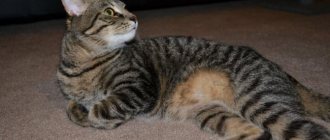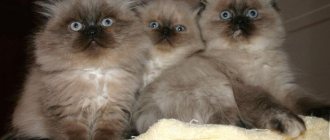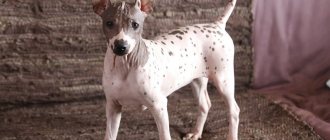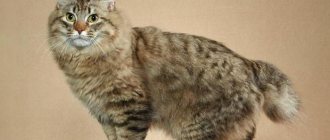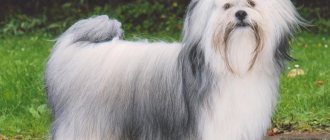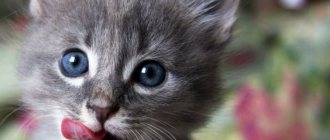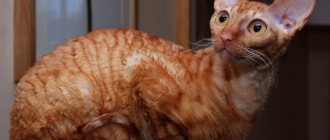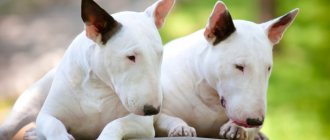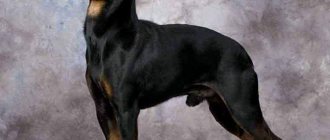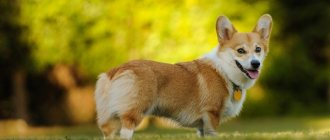History of origin and characteristics
The name of the breed “Bobtail” translated from English means short tail (bob tail). This variety includes cats that have a very short tail or no tail at all. This feature is due to a genetic mutation that has become fixed in the animal’s phenotype.
The bobtail's short tail is the result of a genetic mutation.
There are several types of bobtails:
- Kuril;
- Karelian;
- American;
- Japanese;
- Mekong.
Each of them has its own origin story.
Kurilian Bobtail
The Kurilian Bobtail is considered an indigenous Russian cat breed. This means that the cat is an indigenous inhabitant of the place where it was first discovered - on the Kuril Islands.
Currently, there is no proven theory of the origin of this breed, but there are suggestions that it was formed by combining Japanese bobtails, which were brought to the island by fishermen and merchants, and Siberian cats. For a long time, only the indigenous inhabitants of the islands and rare travelers knew about the Kuril Bobtails. The situation changed only in the 20th century. Until the 80s, tailless kittens were taken as exotic pets to surprise guests. And only at the end of the second millennium they began to take a serious interest in Kurilian bobtails.
The predatory look of the Kurilian Bobtail reminds of the times when they lived in the wild
At first these cats were identified at shows as Japanese Bobtails. But then it was noticed that Kuril individuals have a slightly different coat texture, muzzle shape and body bones. Therefore, it was decided to identify a new breed.
The Kurilian Bobtail standard was developed in 1991 in Russia. The World Cat Federation (WCF) recognized this breed in 1994. The standard was slightly edited in 2001 and is still in effect today.
The first officially registered Kurilian Bobtail was a cat named Chip-O.
Video: features of the Kuril Bobtail
Karelian Bobtail
It is believed that these tailless beauties have lived in the dense forests of Karelia for a long time. There is an assumption that the ancestors of the Karelian bobtails were Norwegian cats, which, according to some scientists, bit off the tails of newborn kittens. Presumably this led to a genetic mutation.
Karelian Bobtails are slightly smaller than their Kurilian counterparts
Residents of Karelian villages believed that these cats attracted happiness and therefore often let them into their homes. This is how these unusual animals lived in the outback of Karelia until felinology (the science of domestic cats) began to emerge in the USSR.
The Karelian Bobtail made its debut at the exhibition in 1987, at which time the first breed standard was described. In 1994, the World Cat Federation (WCF) recognized these unusual fluffies. Unfortunately, at present they are not very popular; they rarely participate in exhibitions.
The breed standard recognizes 2 types of Karelians:
- short-haired (have a very thick undercoat);
- with medium length hair.
Japanese Bobtail
The origin of the breed corresponds to the name of the cat - it comes from Japan. This breed has been known for a very long time; its representatives can be found in ancient paintings and engravings of the imperial palace.
Short-tailed cats were considered to bring good luck in Japan.
Cats in Japan were highly respected, but only those without a tail. In ancient times, the Japanese believed that cats with long tails brought bad luck, so they cut them off. There is an assumption that centuries of tail trimming led to a mutation that caused the formation of this unusual breed.
In Japan, a cat with a short tail can easily be seen on the street.
In 1968, the Japanese Bobtail came to the United States, and since then people have become seriously interested in this breed. The short-haired "Japanese" were recognized in 1976, and the long-haired ones received recognition in 1993.
In Japan, cats with short tails are called "mi-ke".
Video: about the Japanese Bobtail breed
Mekong Bobtail
The Mekong Bobtail is another representative of an ancient cat breed. The banks of the Mekong River are considered the homeland of these purrs. There is a legend that in ancient times these animals guarded ancient vases in temples in southeast Asia.
It was convenient to hang jewelry on the short tail of the Mekong Bobtail, which is what local princesses did while swimming in the river.
For a long time, these tailless beauties were a national treasure; they were not allowed to be taken out of the country. Only the most honored guests could receive such a kitten as a gift.
Mekong Bobtails were not allowed to be exported from Thailand for a long time.
The breed began to develop thanks to Russian breeders. The first Mekongs came to Russia at the end of the 18th century. They were presented to Nicholas II by the Thai king as a sign of friendship between the states. And if in Europe at that time the short hooked tail of bobtails was considered a defect, then in Russia it was a sign of the purity of the breed.
The first standard for the Mekong cat breed was also developed by the Russians in 1994. The World Cat Organization recognized the Mekong cat in 2003.
Currently, this is a rather rare breed, but its popularity is gaining momentum, because many people so want to have this exotic beauty.
Externally, Mekong cats are very similar to Thai cats. But they differ in the structure of their heads, the position of their eyes, the size of their ears, the height of their paws and, of course, their unusual tail.
The Mekong Bobtail has a very charismatic appearance, reminiscent of a Thai cat.
Video: about Mekong Bobtails
American Bobtail
Another name for the American Bobtail is the Yankee Bob. There are several versions of the origin of the breed. According to the first, the founder of the breed was a kitten obtained from a cat with a tiny tail found in Southern Arizona in the 60s of the 20th century and a Siamese cat. The baby had a short tail, which led breeders to the idea that short tails were passed on genetically.
At exhibitions, preference is given to American bobtails with a “wild tabby color”
According to the second version, generally accepted among scientists, the breed was formed due to a random mutation that occurred when crossing Ragdoll cats.
There is also an assumption that the progenitors of the American Bobtail could be Manx, Japanese Bobtail, representatives of other breeds and even lynx.
The first American Bobtail standard was adopted in 1970. Unfortunately, some time after the breed was developed, its degeneration began to occur due to their crossing with close relatives. But in the 80s of the 20th century, measures began to be taken to revive the American bobtail.
Interestingly, purebred cats were not used to revive the breed. Representatives of American Bobtails were bred with ordinary outbred individuals that had the necessary characteristics: a short tail, brown tabby color and medium or long hair.
The American Bobtail was the first to be recognized as an independent breed by the International Cat Association (TICA) in 1989. The Cat Fancier's Association (CFA) did this only in 2000. Currently, cats of this breed are not very popular in the world community. Geographically, they are mainly distributed in the USA and Canada.
Video: features of the American Bobtail
Table: characteristic features of different bobtail breeds
| Characteristic | Kuril | Karelian | Japanese | Mekong | American |
| Body | Compact, muscular, with a slightly arched back and raised croup. | Medium size, not stocky or elongated. | Medium size. The body is graceful and long. The muscles are developed. | Medium, muscular, but at the same time graceful. | Medium size. The chest is wide. The body is muscular. |
| Limbs | Strong. The hind legs are longer than the front ones, the paws are rounded. | Medium length and strong, hind legs slightly longer. Paws are round in shape. | Long, slender, strong. The hind ones are much longer than the front ones, which is visible to the naked eye. Oval shaped paws. | Average, slim. Oval shaped paws. | Proportional to the body, strong. In long-haired individuals, tufts of hair between the toes are welcome. The paws are large and round in shape. |
| Tail | From 3 to 8 cm excluding wool. It must have creases and bends, one or more knots in various combinations. The fur on the tail forms a pompom. | From 4 to 13 cm. With kinks or curved. The wool forms a "pompom" at the end. | Not longer than 3 inches (7.62 cm), but clearly visible. May consist of one or more bends, corners, etc. | Must have at least 3 vertebrae, but at the same time a size longer than 1/4 of the body is not allowed. Hooks and knots on the tail can be in any combination. | From 2.5 to 8 cm. |
| Head | Large, trapezoidal in shape, with smooth contours. The muzzle is wide. | It has the shape of an isosceles triangle. The profile is almost straight. The forehead and cheeks are flat. The muzzle and chin are narrow. | The shape is an equilateral triangle, but in appearance it appears long and elongated. The nose is long and wide. High cheekbones. | Round shape. Almost flat on top. The muzzle is oval. The nose is “Roman” (wide with a hump). | Wedge-shaped, with rounded contours. Proportional to the body. The muzzle is wide. Clearly prominent cheeks and mustache pads. |
| Ears | Medium in size. Wide. Quite widely set. The ends are rounded. | Large, high set, vertical. | Large, widely set. Pointed upward. | Large, wide at the base. The tips are slightly rounded. Set high and laid back slightly. | The ears are medium or slightly larger in size with slightly rounded ends. Tassels on the ears are a desirable element. The nose is wide, with a small hump on the bridge of the nose. |
| Eyes | Round, widely set. The color is in harmony with the color. | Oval shaped, close set. The color matches the color. | Large, oval. In profile you can see that they have a pronounced slope. The eyes are in harmony with the color, although blue-eyed individuals and even those with different eye colors are acceptable. | Large, oval, bright blue. | Large, almond-shaped. Color may not correspond to color, with the exception of mink, sepia and colorpoint colors. |
| Wool | Middle length. The undercoat is weakly expressed. It is desirable to have a “collar”, “jabot”, “pants”, ear brushes and tassels. | Short or medium length. | Can be of any length: short, extended and long. Accordingly, short-haired and long-haired individuals are distinguished. The undercoat is weakly expressed in each type of Japanese Bobtail. The fur on the tail forms a pompom. The hair on the front part of the body may be shorter than on the back. It is desirable to have tufts in the ears and legs. | Short, silky. The undercoat is weakly expressed. | There are short-haired and long-haired. In both cases, the coat is very thick, the undercoat is moderately developed. In individuals with long hair, increased shaggyness is observed on the chest, paws, belly and tail. |
| Color | All colors are recognized except chocolate, lilac, cinnamon, fawn (including tabby, bicolor, tricolor), as well as acromelanic (colorpoint). | All colors are recognized except chocolate, lilac, cinnamon, fawn (including tabby, bicolor, tricolor), as well as acromelanic (colorpoint). | All colors are acceptable, except chocolate, lilac, colorpoint, ticked tabby. The most common colors are bicolor and tricolor. | Colorpoint of any point color without white. The paws, tail and muzzle are darker in color. | May vary. The most preferred coat color is tabby. |
| Weight | Male - 5-6 kg, female - 3-4 kg. | Male - 4-6 kg, female - 2.5-4 kg. | Cat – 2.5–3.5 kg, cat – 4–5 kg. | Cat - 2.5–4 kg, cat - up to 6 kg. | 4–7 kg. Males are usually larger than cats. |
| Height at withers | Up to 30 cm. | Up to 28 cm. | Up to 32 cm. | Up to 30 cm. | Up to 30 cm. |
Dog's coat and color
Bobtail fur is coarse, rich, with soft waves. The undercoat comes in two varieties: small and dense, or long. The fur covers the entire body uniformly. The hind limbs are covered more densely than the rest of the body.
The body and hind limbs are of the same color. The bottom of the limbs can be snow-white, like socks. The skull, neck and forelimbs are likely to be snow-white. You can evaluate the appearance from the photo of the bobtail.
All kinds of chestnut tones are considered undesirable colors. Cubs are painted snow-white and black, which changes with age.
Character of bobtails
The common features of any bobtail are goodwill and affection for the owner. For this love and devotion to humans, they are often called dogs in cat form.
Japanese bobtails even know how to give a paw as a greeting. There are numerous statues of cats in this pose in Japanese temples.
A Japanese figurine of a cat with a vertically raised paw - maneki-neko - brings good luck
Bobtails are distinguished by their high trainability, playfulness and irrepressible energy. These cats can be taken for walks on a leash.
Owners of Japanese Bobtails may have problems with training; they are quite stubborn animals. It is difficult to get them to perform any trick. But Kurilian Bobtails, on the contrary, are very obedient and unforgiving. The owner only needs to point out the pet’s fault once, and the smoker will never do it again. Moreover, the owners note that these smart animals never mark their territory. And this is an undeniable advantage when it comes to a cat.
Bobtails are excellent rat catchers. Their hunting instinct does not disappear even in those cats who have never seen a mouse. At the same time, they get along very well with numerous small pets: parrots, hamsters, etc. These cats are very smart and unpretentious. They are not at all afraid of water, unlike most other representatives of the cat family.
Surprisingly, bobtails love to swim
Bobtails are friendly towards guests, although somewhat wary. But they get along very well with children and other pets. Even the seemingly stern Kuril cat turns out to be kind and affectionate.
At the same time, cats of this breed are unobtrusive, although they love to sleep on their owner’s lap. They rarely speak. Their melodic meow is very different from that of other cats. Perhaps the most delicate are the Mekong. They rarely express their emotions. But the owners of these unusual purrs noted that Thai beauties are quite vindictive. And Karelian bobtails, as breeders note, know how to take offense at their owner’s raised voice: they portray sadness on their faces and do not approach the person who offended them until he speaks kindly to his offended pet.
In general, bobtails are cats with completely different characters. Among them there are grumblers, extraordinary cuties, fidgets, and phlegmatic people. The list of temperaments could go on for a very long time. But they are united by goodwill and love for people.
It is interesting that in a family of Mekong Bobtails, the father takes responsibility for raising and caring for the babies. He licks his offspring with pleasure, teaches them the rules of cat life, and attracts them to hunting and eating adult food. Among the Kurils, both parents take on the responsibilities of raising the younger generation; the father is always ready to replace the mother.
Video: Kurilian Bobtail bathes
Features of character and behavior
- The Bobtail is a typical herding dog, with a calm, balanced character and sufficient physical strength to lead a herd. With proper upbringing, a shepherd dog becomes a good guard and worker, respects people and never contradicts the words of its owner.
- At first glance, Old English Sheepdogs may seem arrogant and phlegmatic, but in fact they are very playful and active, especially in nature. They cannot be turned into an aggressive dog, even under the harshest conditions. However, many are prone to cowardice.
Advantages
- A dog bred to work for humans must have not only a developed muscular system and endurance. It takes intelligence and ingenuity to perform the duties of a herdsman. Bobtail suits all parameters. In addition, he is not prone to aggression and a hostile mood.
- This breed is well trained and, thanks to its restraint and high intelligence, easily copes with any tasks. In the absence of physical activity and education, shepherd dogs become lazy and cowardly.
- They get along well with children, they can become good nannies - they watch unobtrusively, play carefully, and will always help . They love their owners devotedly, are not prone to running away, family is a priority for Bobtails.
- Playful and funny, Old English Sheepdogs look original: they look like large teddy bears. They like to be the center of attention, they love people and any society in general.
- Assess the behavior and mood of the owner. These dogs will not be overly intrusive, they would rather lie at your feet and try to lighten the mood.
Flaws
- They can act a little arrogant and proud . If raised incorrectly, the dog will either subjugate the will of the owner and become the main one in the house, or will be cowardly and shy. In addition, shepherd dogs are prone to constant control of household members (shepherd instincts).
- Excessive activity can cause inconvenience if the dog's area is small . In addition, Bobtails shed heavily and have a specific smell.
Health
Bobtails have fairly good health. Currently, no genetic diseases have been identified. However, some breeders note that the absence of a tail can be the cause of inflammatory processes in the anus and rectal prolapse. Therefore, it is extremely important to periodically examine the animal for redness or cracking in the anus. Otherwise, all types of bobtails require the usual preventive vaccinations and antiparasitic measures for any cat.
The life expectancy of bobtails is quite high. They live for about 15 years, but with proper care they can live longer.
The longest-livers among bobtails, and cats in general, are Mekongs. Their lifespan is 20–25 years.
Description
The Bobtail is known for its thick, lush, gorgeous coat. It attracts attention, which is why animals are valued at exhibitions or various domestic dog competitions: the appearance of an Old English Sheepdog on stage is always a charming sight. But representatives of the breed are not decorative exhibits at all. They find the meaning of their existence in serving people. Therefore, the pet needs human company, kindness and affection.
The dog's bark is juicy, sonorous, and somewhat specific. A representative of the breed barks only when he really sees a danger that is worth human attention.
Height at the withers is 55–62 kg, weight reaches 25–38 kg. The bobtail is well built, strong and massive. Its body is shaped like a pear, its back is wide, without bulges, with a prominent croup, massive and muscular appearance. The hocks are low and the thighs are well muscled. From birth, puppies are deprived of a tail; If the baby was born with a tail, it must be docked as soon as possible. The standard allows about 4 cm of the length of this organ to be left.
How to care for a bobtail
The fur of these unusual cats has an amazing property: even long hair does not tangle or form tangles. That is why caring for the coat is very simple: washing should be done only when absolutely necessary, and brushing should be kept to a minimum. It is enough to go over the fur with a brush-mitten or comb 1-2 times a week to remove dead hairs.
Although bobtails are not afraid of water and even love to swim in ponds, this does not mean that they will wash themselves in the bathroom with the same joy. Some cats may be outraged and actively resist this procedure.
Bobtails love water, but that doesn't mean they will also love being washed in the bathtub.
In some sources you can find information that bobtails do not need to be combed at all. I beg to differ with this. Yes, in the wild no one takes care of the fur. But since in this case we are talking about a pet, it is necessary to comb it periodically. At a minimum, there will be less pet hair in the house, which, although not in large quantities, still appears. The same applies to the issue of cutting nails. Some authors of articles say that tailless cats do not need it. If the cat regularly climbs trees and hunts, then perhaps there is no need to trim its claws. But if the animal lives in apartment conditions, then a haircut is indispensable.
Bobtails of any variety need to regularly clean their ears and wash their eyes. It is enough to do this 1-2 times a week. The ear cleaning procedure involves soaking a cotton pad in a special solution and gently wiping the ears with it. To wash your eyes, you should also moisten a cotton pad with warm water and remove the discharge from them in the direction from the outer corner of the eye to the inner.
Don't forget about your teeth. Once a week you should definitely brush them, as if you don’t take care of your mouth, tartar will form, which can lead to serious health problems.
Video: how to brush your cat's teeth
Toilet for a cat
Bobtails learn to use the toilet very quickly, usually this happens in the parental home. You can hear from some breeders that in order for the kitten to adapt faster to its new owners after arriving at the house, you need to buy the same tray that it used in the nursery.
Since the bobtail is a medium-sized cat, you need to purchase a fairly large litter box. The range of products for cat litter is very large, but it is still the cat who will choose the appropriate model. If the purchased toilet is not to her taste, she will simply ignore it.
The issue with the filler is resolved in the same way. One cat will calmly go to the toilet on scraps of newspaper placed in it, while the other will do its “dirty” deeds only in a highly absorbent litter. One rule is always the same: the tray must always be clean, since bobtails are very clean. Otherwise, the cat will simply go to the toilet in another place.
And the owner will no longer like this.
What to feed a handsome bobtail
Until the kitten reaches three months of age, it is recommended to eat 6 meals a day. At six months the number of feedings should be reduced to 4 times, and at 9 months the pet can be transferred to an adult feeding regimen - 2 times a day. You can feed your bobtail both natural products and ready-made industrial food.
Table: natural products that must be in a cat’s diet
| Product | Feeding frequency |
| Raw frozen beef - at least 30 grams for a kitten, 100-120 grams for an adult cat. | Every day. |
| Boiled chicken without bones | 3–4 times a week. |
| Chicken or beef by-products (heart, lungs, liver, kidneys) raw (frozen) or boiled. | 2–3 times a week. Liver - once a week. |
| Boiled low-fat fish, without bones, preferably sea fish (rarely, because fish destroys vitamin B in the cat’s body). Raw fish should not be given - it leads to the appearance of worms. | Cats - 1-2 times a week, cats - 1 time a week or less. |
| Egg yolk (whites should not be given) raw or boiled in pure form; You can grind it with milk, kefir, or add it to porridge. | 1–2 times a week. |
| Goat's milk, fresh, raw or boiled, or dried from a veterinary store (only for kittens under 3 months, because an adult cat cannot digest milk and causes an upset stomach, but a kitten needs it). You can add a little honey (no sugar). Also given to pregnant and lactating cats. | You can switch to fermented milk products every day if you have an upset stomach. |
| Liquid milk porridges (for kittens under 3 months of age): semolina, rice, oatmeal. No sugar, maybe a little honey. | You can do it every day. |
| Fermented milk products: kefir, sour cream, fermented baked milk, yogurt, cream - all of medium fat content, as well as cheese. | You can do it every day. Cheese once a week. |
| Fresh, non-acidic cottage cheese - you can mix it with sour cream or raw egg yolk (you can add just a little honey). | Kittens - 3-4 times a week. Adult cats - 1-2 times a week. |
| Cereals: oatmeal (steamed), rice, buckwheat, wheat grits (boiled) - mixed in a 1:2 ratio with boiled meat or boiled fish. | Few times a week. |
| Vegetables, raw or boiled (in the form of puree): carrots, cauliflower, green (asparagus) beans, etc. - mixed in a 1:2 ratio with boiled meat or boiled fish. | Several times a week (alternate with cereals). |
| Greens - lettuce, spinach - are chopped and added to food. It’s better to use sprouted wheat grains or grow grass on the windowsill (from wheat or oats). NO grass from the street! | Add to food several times a week; if there is grown grass, the cat will eat it itself. |
In some sources you can find information that it is better not to give fish to cats. However, in the natural habitat of the Kuril Bobtail, fish was an important part of their diet. And my personal experience is that fish in moderation in the diet of a healthy cat will not harm it. I often fed my cats fish, and none of them had kidney problems.
The following foods are prohibited:
- food from the human table;
- salty, fried, smoked, sweet food;
- pork, lamb;
- goose, duck;
- spleen, chicken necks and bones;
- seafood;
- cream, sour cream, butter, salted cheese;
- citruses, kiwi, pineapple;
- persimmon;
- rhubarb;
- nuts;
- beans;
- potatoes, broccoli;
- onion garlic;
- tomatoes, eggplants;
- mushrooms;
- chocolate;
- Tea coffee;
- alcohol;
- bread and other baked goods.
The proportion of proteins, fats and carbohydrates should look like this: 60–70% protein, 10% fat and 20–30% carbohydrates. It is best to check with your veterinarian for serving size.
There are 2 ways to determine the required amount of food:
- measuring portions with scales at the rate of 5–7% of the cat’s weight;
- determining the amount of food by observing the animal (a contented purring cat is a sign that it is full).
On the one hand, the second method of determining the portion size is optimal, since each animal has a different appetite. But on the other hand, this can lead to obesity of your furry pet. In my opinion, it is still better to use the first method.
Ready-made feed
Ready-made food is divided into dry and canned. It is better to give preference to the latter, as they are considered more beneficial for cat health. But often bobtails choose to eat dry food, as experienced breeders say.
In any case, you can feed your bobtail only with premium industrial food, since cheaper products cannot always sufficiently satisfy the needs of this animal.
Often on cat forums you can witness heated debates regarding the combination of natural food with dry and canned food. Some breeders insist that it is possible to mix all types of feeding - this only benefits the cats. But others are categorically against this, because they believe that such a combination of food can lead to serious health problems. In order not to harm your pet’s health, this issue should be resolved only with a specialist.
Nutritionists do not recommend combining industrial food with homemade food, but some specialist doctors and, more often, breeders, argue that industrial food should not form the basis of a cat’s diet, they can be given as an additive to the main diet, and their opinion boils down to the fact that industrial feed, both dry and liquid, should make up no more than 25% of the main diet. Others hold a diametrically opposite opinion - the introduction of natural products should not exceed a quarter of the amount of industrial feed, which is the basic one in the diet structure. The specialists of our clinic do not agree with this position, both the first and the second - this introduces an imbalance in the diet, provokes instability of digestion, and the whims of the cat. When layering natural meat additives, it often provokes not only the whims of the cat, but also an imbalance of food in ballast substances with a tendency to form constipation, and there is also a violation of calcium metabolism due to a lack of calcium and excess phosphorus in meat products, which leads to the need for corrective input of additional the amount of fiber in the form of bran or vegetables and mineral supplements. The only argument in this case can only be the underestimated amount of high-quality protein in industrial feed and the intensive growth of the animal, but again, when using high-quality food appropriate for the age of the animal, such problems are unlikely. Adding industrial feed to the main “natural” diet makes no sense at all, while such an introduction of industrial feed not only does not correct the main diet, but only introduces additional complexity into balancing the main diet.
Chermoshentseva Galina Vladimirovna, chief veterinarian of the UNIVER-West veterinary clinic
https://www.vet-univer.com/content/articles/index.php?ELEMENT_ID=349
The serving size must comply with the standards indicated on the packaging; only a veterinarian can adjust it. It should be noted that for kittens it is necessary to buy special food intended specifically for them.
To avoid overfeeding your pet, you need to monitor the portion size
How to choose a bobtail kitten
These cats are exotic, so it is better to purchase from nurseries and breeders with a good reputation. First of all, before purchasing an animal, you should decide on its gender, as well as the length of its fur.
Kitties are usually more flexible and affectionate than cats. But cats are more playful. An important question when deciding on the gender of the animal is whether you want to earn income from selling kittens. If yes, then you need to choose a cat. If the continuation of the cat family is not included in the plans, then the animal can be castrated or sterilized. This is done before the onset of sexual maturity, that is, at about 6 months.
Despite the fact that bobtails do not require special coat care, short-tailed breeds are still easier to care for. This should be taken into account by those people who are very busy and will not be able to comb their handsome man 2 times a week.
The general rules for choosing a kitten are no different from buying an animal of another breed:
- The kitten should be playful and not afraid to approach people.
- The skin, eyes and ears must be clean.
- There should be no redness or cracks on the anus.
- It is recommended to separate kittens from their mother no earlier than 3 months after birth; this is the optimal age for purchase.
Kittens can be purchased after all vaccinations have been completed.
- The tummy should not be bloated.
- The mouth should be clean and pink. A pale color indicates anemia, and a red color indicates an inflammatory process. The presence of ulcers and black crusts indicates a viral infection.
A true bobtail has a short tail. The presence of creases and hooks depends on the breed. Mekong Bobtails are usually born white and develop their characteristic color as they approach their first year of age.
All bobtail kittens are distinguished primarily by their short tail.
The following prices for kittens can be found on the Internet:
- Kuril - from 10 thousand rubles;
- Karelian - from 30 thousand rubles;
- Japanese - from 15 thousand rubles;
- Mekong - from 10 thousand rubles;
- American - from 30 thousand rubles.
How much does a Kurilian Bobtail kitten cost?
The cost of Kuril Bobtail kittens depends on the following factors: gender of the baby, purpose (companion or exhibitor), color, compliance with standards, pedigree.
Breeders who raise animals for sale, who have invested a lot of effort, love and money into the business, are unlikely to underestimate the work. Therefore, prices for purebred cats vary from 10,000 to 50,000 rubles.
Breeding
To knit bobtails, you should adhere to the following recommendations:
- At the time of mating, the cat should be in 1-2 heats. Moreover, she should not be younger than 1 year, since before this period her body is not yet fully formed. The cat must also be at least 1 year old. The optimal age is one and a half years.
- At least one partner must already be experienced in this matter, so that the mating is not disrupted by the confusion of both animals.
- Both partners must be healthy, vaccinated and dewormed 14 days before this day.
- You should not wash the cat before mating, so as not to deprive her of the natural smell that attracts the cat so much.
- The meeting should be scheduled on the cat’s territory so that he feels like a master and does not waste time adapting.
- Mating is prescribed on the 2nd–3rd day of estrus. The cat should be left with the cat for 3-5 days.
The peculiarity of bobtails is that they are prohibited from crossing with cats of other breeds. You should also keep in mind that when choosing a partner, you need to pay attention to the length of his tail. If a cat’s tail reaches 8–12 cm in length, then a cat’s tail should be much shorter - this results in offspring with a tail from 3 to 8 cm.
Typically, pregnancy and childbirth proceed without any special features. But if the owner is inexperienced, it is better to play it safe and invite a veterinarian to attend the birth.
Education and training
Bobtails are smart and obedient dogs. They are not difficult to raise and train. Experienced dog breeders can cope with this task without involving the resources of training schools.
The first thing to start with is establishing a hierarchy and trust between the owner and the puppy. The bobtail must recognize the owner as the main one, only then will he obey unconditionally.
Behavioral norms and socialization are easily learned by a bobtail puppy. A little persistence and patience - and the dog obeys without a word. At 2-3 months, the baby is accustomed to a leash and begins to learn simple commands. The motivation is the owner's praise.
Bobtails are often used in circus performances: artistic dogs are happy to perform tricks and complex commands.
It is important to take your time and move on to the next exercises only after consolidating the commands you have already learned.
The dog's good-natured appearance can deceive intruders. But the owner can be sure: the bobtail will defend its owner, just as its ancestors used to protect the herds from predators and tramps.
